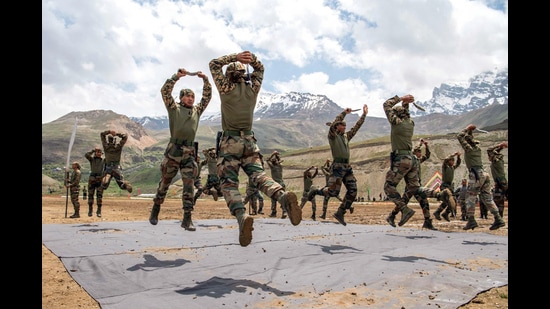I have never been convinced of the wisdom of Agnipath — the new and contentious short-term military recruitment scheme — that is back in the headlines.

Today the focus is on the political row between Rahul Gandhi and the Narendra Modi government, after the death of Agniveer Ajay Kumar from Punjab who died in a landmine blast. The government says Kumar’s family will receive a compensation of ₹1.65 crore, of which ₹98 lakh has already been paid. The Congress says the money received by the family, so far, is group insurance and bank insurance, and can’t be considered government compensation.
As an unseemly battle rages, Charanjat Singh, the father of Kumar, who was 23 years old when he died, has a plea: “Mere bete par rajneeti nahi honi chahiye” (There shouldn’t be politics over my son). Evidently overwhelmed by the media and political attention, and the attempts to push and pull him into taking sides, he praised both Rahul Gandhi and defence minister Rajnath Singh, but did say in the end that “My son is a hero, a shaheed… and he should be recognised as such, including the rights to a pension.”
Now, despite TV news channels casually using the phrase ‘martyr’, this nomenclature simply does not exist in the military.
But we should focus, not on the words, but on the spirit of what a devastated father is trying to argue. The Agnipath scheme effectively creates two classes of soldiers within the same unit — the Agniveer and the regular jawan. But the risks they undertake are often the same. Kumar was posted in Rajouri, in Jammu, near the Line of Control. His father is absolutely right in asking why his death in the line of duty should be treated as any different from that of other soldiers.
A parliamentary panel, headed by a Bharatiya Janata Party member of Parliament, also concurred in February this year. The parliamentary standing committee on defence, led by Jual Oram, recommended that families of Agniveers who lose their lives while on duty be given the same benefits as any other soldier. The panel also pointed out that other than some reservation in the central armed police forces (10% of vacancies) there was no other assured employment or skill development programme, especially for Agniveers.
So, basically, a young man between the ages of 17 and 21 years, often straight out of school, who enters the military as an Agniveer, earns ₹30,000 per month in year one, going up to a maximum of ₹40,000 a month, and exits in four years with a lump sum of approximately ₹11 lakh. Only 25% of recruits have a chance of being retained in the military. If the soldier dies or is disabled, his family is entitled to a one-time compensation package, but no lifetime pension or other benefits.
There is an ethical problem with placing different values on life and death.
But there are other grave issues too. In the military, your paltan is everything. Soldiers will take a bullet before they will let their buddy take one. The honour of the regiment is the driver of passion and loyalty. With its emotionless, pass-through model and short training capsules, Agniveer potentially impacts unit cohesion and combat efficiency.
Yes, I take all the points about how modern warfare needs new tools. But do we really have to upgrade our technology and weaponry at the cost of the foot soldier? Why not increase defence spending, instead?
We are on the verge of 25 years since the Kargil War, during which then Army Chief General Ved Malik, famously said, “We will fight with what we have.” The Indian soldier is the product of a passion project. Many recruits may join the Fauj in search of security, but on the battlefield, they are the hardiest, bravest men in the world. And for those pointing to examples from the West, look at what happened to US troops in Afghanistan and Iraq. The absence of boots-on-the-ground training made both battles unwinnable for them.
No amount of modernisation will replace the need for a soldier to stand hours on end at posts built on jagged peaks, in inhuman weather. There are already two active theatres of conflict — the Line of Control with Pakistan, and the eastern Ladakh region, where China is constantly seeking to intrude. Amongst the earliest Agniveer casualties was that of Akshay Gawate, who died from complications after a Siachen posting. Is his death any less than that of his comrades?
And do we really believe that corporate India and the private sector will generously open its doors to jawans after a four-year term? Not after we have seen jawans who spend a lifetime of military duty struggle to get jobs. Remember the Tiger Hill Vir Chakra spotted directing traffic in Punjab?
We know from the memoirs of former Army chief, General Manoj Naravane, that the Army was not just “taken by surprise” when the scheme was rolled out, but that it also argued for 75% of recruits to be retained. The military also put its foot down on the initial recommendation of ₹20,000 as the starting salary per month, which he wrote “was just not acceptable… Surely a soldier could not be compared to a daily wage labourer?”
Above all, why was such a drastic change, one that directly impacts national security, implemented without so much as a pilot project or trial?
Trolls who talk big on nationalism, today cackle about canteen benefits to Faujis. The pettiness is astonishing.
Agnipath needs to be revisited. Roll it back or change it. Status quo is not an option.
Barkha Dutt is an award-winning journalist and author. The views expressed are personal


